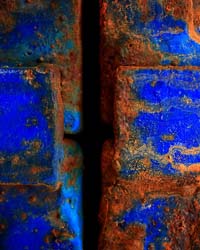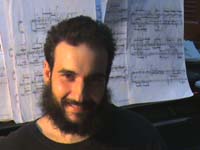Echoes and Hieroglyphs 
[English] - [Ελληνικά] - [Deutsch]
Echoes and Hieroglyphs:
Works by I. Xenakis, H. Lachenmann, K. Stockhausen,B. Ferneyhough.
I. Xenakis: Mists
H. Lachenmann:Echo andante
K. Stockhausen: Klavierstück VII
B. Ferneyhough:Opus Contra Naturam
“The construction of the piece follows two main ideas.One is the exploration of pitch series (scales) and their cyclic transpositions.These series stem from logic functions acting on simpler series of one module.Their exploitation in sound is made either in a contiguous manner (melodically) or by means of stochastic distributions[...] in order to produce sound clouds of defined density; in short, with the aid of random walks (Brownian movements).
The second idea is that of arborescences, in other words of bush-like clusters of melodic lines which undergo various rotations in the time space.” (I. Xenakis, Formalized Music)
“I was influenced and fascinated by the purity and logicality of the then non-figurative vocal part writing of my teacher Nono;here the tones, as held tones, come together during their duration in changing interval relations, with these, by way of flexible dynamics and tone or vocal colors, being even more inwardly articulated and hierarchically graded.My intention of proceeding from such a practice in the development of a compositional pattern for piano was deliberately an attempt to take on a refractory object, with the piano sound permanently slipping through one's fingers.The employment, at the “right time”, of the always-fleeting tone as a component of the interval structures being built-up, taken apart, and rebuilt and the rendering apparent precisely in this way of the stereotypical diminuendo character, while if not surmounting it, then repeatedly outtricking it through the inclusion of pedal and flageolet techniques as well as through the inclusion of “tonal”consconances as overtone specters made audible, led to results in which the initial contradiction became the thematic object and regulated the form of the piece.”
(H. Lachenmann, Musik als existentielle Erfahrung)
“[Opus Contra Naturam] plays a key role in [Shadowtime] in that it represents the orphic descent of Benjamin’s avatar into the Underworld, through whose portals he is welcome […] Opus Contra Naturam is a term taken from Renaissance alchemy and signifies one of the essential moments of transition/transformation which typify that arcane discipline.The piece itself is to be played by a Liberace-like figure or Joker and is to be accompanied by a silent film projection encompassing the chaotic intersection of scenes from fin-de-siécle Berlin cabaret, medieval labyrinths and images from the hyper-dissimulatory environment of present- day Las Vegas.
Formally the work is composed of a large central body of disordered and clamorous fragments framed by a lyrical Introit and a concluding Processional, both of which latter, in the opera, are accompanied by distorted and superposed plainchant quotations.
In keeping with its hallucinatory imagery, the central segment is a piano transcription, commentary and prolongation of an entirely disorderly and prolix body of materials assembled over the space of several months as a sort of musical diary or monstrously autonomous memory trace. Apart from rendering it for piano, little has been done to suggest spurious criteria of coherence: given his fascination with the Surrealistically orderly disorder manifest by Parisian passages, I imagine that Benjamin himself would not have been entirely unappreciative of this aesthetic strategy.”
(B. Ferneyhough, Opus Contra Naturam, Preface)
[Link to Media]
Αντηχήσεις και Ιερογλυφικά
'Εργα των I. Xenakis, H. Lachenmann, K. Stockhausen, B. Ferneyhough
I. Xenakis: Mists
H. Lachenmann:Echo andante
K. Stockhausen: Klavierstück VII
B. Ferneyhough:Opus Contra Naturam
“Η κατασκευή του κομματιού ακολουθεί δύο κυρίως ιδέες: Μία είναι η εξερεύνηση σειρών (κλιμάκων) τονικών υψών και οι κυκλικές τους μεταφορές.Αυτές οι σειρές πηγάζουν από λογικές λειτουργίες που εφαρμόζονται σε απλούστερες σειρές ενός modulo.Η ηχητική τους αξιοποίηση γίνεται είτε σε συνέχεια (μελωδικά) είτε με στοχαστικές κατανομές[..] με στόχο την παραγωγή ηχητικών νεφών καθορισμένης πυκνότητας·εν ολίγοις, με τη βοήθεια τυχαίων κινήσεων (κινήσεις Brown).
Η δεύτερη ιδέα είναι αυτή των διακλαδώσεων, δηλαδή θαμνοειδών “τσαμπιών” από μελωδικές γραμμές, που υπόκεινται σε διάφορες περιστροφές στο χώρο του χρόνου”. (I. Xenakis, Formalized Music)
“Επηρεάστηκα και εντυπωσιάστηκα από την καθαρότητα και λογική της-τότε αμοτιβικής[?]- φωνητικής γραφής του δάσκαλού μου Nono·οι τόνοι εδώ -τόνοι κρατημένοι- σμίγουν στη διάρκειά τους σε μεταβαλλόμενες διαστηματικές σχέσεις, οι οποίες αρθρώνονται ακόμη περισσότερο εσωτερικά και διαφοροποιούνται ιεραρχικά μέσω της χρήσης ευλυ΄γιστων δυναμικών και χρωμάτων, τονικών ή φωνητικών.Η πρόθεσή μου να εκκινήσω από αυτή την πρακτική προς έναν τρόπο γραφής για το πιάνο ήταν ηθελημένα ανάληψη μιας δυ΄σκολης πρόκλησης, καθώς ο ήχος του πιάνου μονίμως ξεγλιστρά μέσα από τα δάχτυλά μας.Η χρήση, στο “σωστό χρόνο” του μονίμως φευγαλέου τόνου, ως ουσιαστικού στοιχείου των διαστηματικών δομών που δομούνται, διαλύονται και αναδομούνται, καθώς και η αποκάλυψη (ακριβώς μέσω αυτού του τρόπου) του στερετυπικού diminuendo χαρακτήρα [του πιάνου], που κι αν δεν μπορεί να ξεπεραστεί, μπορεί τουλάχιστον να ξεγελαστεί με την ειδική χρήση του pedal και των αρμονικών, καθώς και τη συμπερίληψη “τονικών” συμφωνιών σαν σειρές ανώτερων αρμονικών που γίνονται ακουστές, οδήγησε σε αποτελέσματα όπου αυτή η αρχική δυσκολία έγινε το θέμα και ο ρυθμιστής της νμορφής του κομματιού”.
(H. Lachenmann, Musik als existentielle Erfahrung)
[ Το Opus Contra Naturam] παίζει κεντρικό ρόλο [στο Shadowtime], καθώς αναπαριστά την ορφική κάθοδο του φαντάσματος του Benjamin στον Κάτω κόσμο, που του ανοίγει τις πύλες διάπλατα [..] Ο όρος Opus Contra naturam προέρχεται από την αλχημεία της Αναγέννησης και σηματοδοτεί μία από τις ουσιώδεις στιγμές της μετάβασης/μετουσίωσης που είναι χαρακτηριστική αυτής της μυστικής Τέχνης.Το κομμάτι καθ'αυτό πρέπει να παιχτεί από μία φιγούρα παρόμοια με τον Liberace ή κάποιο Joker και πρέπει να συνοδεύεται από μία σιωπηλή προβολή φιλμ, που συνίσταται στη χαοτική διασταύρωση σκηνών από βερολινέζικα ψαμπαρέ, μεσαιωνικούς λαβυρίνθους κι εικόνες από το υπερ-δυσπροσομοιωτικό περιβάλλον του σημερινού Las Vegas.
Μορφολογικά το έργο αποτελείται από ένα μεγάλο κεντρικό σώμα άτακτων και θορυβωδών θραυσμάτων, που περιβάλλονται από ένα Introit και ένα Processional (ύμνοι εισόδου-εξόδου), τα οποία στη όπερα συνοδεύονται από αλλοιωμένα και υπερτιθέμενα παραθέματα Γρηγοριανού μέλους.
Σε αρμονία με την ψευδεσθητική του εικονοποιεία, το κεντρικό κομμάτι είναι μεταγραφή για πιάνο, σχόλιο και επέκταση ενός τελείως ανοργάνωτου και φλύαρου σώματος υλικών που συσσωρεύτικαν για αρκετούς μήνες εν είδει μουσικού ημερολογίου ή τερατωδώς αυτόνομου ίχνους μνήμης.Εκτός από την μεταφορά τους στο πιάνο, λίγα έγιναν για να υπονοήσουν κάποια σκόρπια κριτήρια συνοχής: δεδομένης της γοητείας του με τη σουρεαλιστική τακτοποιημένη αταξία έτσι όπως εκφράζεται στις Στοές και τα περάσματα του Παρισιού, φαντάζομαι ότι ο ίδιος ο Benjamin δε θα είχε αποκηρύξει αυτή την αισθητική στρατηγική”.(B. Ferneyhough, Opus Contra Naturam, Εισαγωγή)
Echoes und Hieroglyphen:
Werke von I. Xenakis, H. Lachenmann, K. Stockhausen, B. Ferneyhough
Programm:
I. Xenakis: Mists
H. Lachenmann:Echo andante
K. Stockhausen: Klavierstück VII
B. Ferneyhough:Opus Contra Naturam
"Die Konstruktion des Stückes basiert auf zwei Hauptideen. Eine Idee ist die Erforschung von Aneinanderreihungen definierter Tonstufen (Skalen) und ihrer periodischen Transpositionen. Diese Tonreihen stammen von logischen Funktionen, die einfachere Serien von einzelnen Moduli verwenden. Klanglich werden sie in zwei Varianten genutzt: entweder als benachbarte Tonstufen (Melodien), oder als stochastische Felder [...], die „Wolken“ von Tönen definierter Dichte bilden; kurz, mithilfe von Zufallsbewegungen bzw. Irrfahrten (Brownsche Bewegungen).
Die zweite Idee sind die baumartigen Verzweigungen, mit anderen Worten, strauchartige Cluster von melodischen Linien, im Zeitraum rotierend." (I. Xenakis, Formalisierte Musik)
“Ich war geprägt und fasziniert von der Reinheit und Konsequenz des damaligen nonfigurativen Vokalsatzes meines Lehrers Nono, bei welchem die Töne als gehaltene wärend ihrer Dauer in fließende Intervallbeziehungen zueinander treten, wobei diese über flexible Dynamik und Klang-beziehungweise Vokalfarben noch weiter innerlich artikuliert und hierarcisch abgestuft werden.
Mein Vorhaben, von solcher Praxis bei der Entwicklung eines Klaviersatzes auszugehen(Nono hat damals wohlweislich nichts für Klavier, überhaupt kaum etwas für Soloinstrumente geschrieben), war bewußt ein Versuch am widerspenstigen Object, wo doch der Klavierklang permanent unter den Händen zerrinnt.
Den ständig fliehenden Ton als Komponente von sich auf-, ab-, und umbauenden Intervallstrukturen “rechtzeitig”zu nutzen und gerade dadurch den stereotypen Diminuendo-Charakter zugleich bewußt zu machen und wenn schon nicnt zu überwinden, so doch immer wieder zu überlisten unter Einbeziehung von Pedal- und Flageollet-Techniken (mittels stumm gedrückter Tasten), aber auch durch Einbeziehung von “tonalen” Konsonanzen als hörbar gemachten Obertonspektren, führte zu Ergebnissen, in denen der Ausgangswiderspruch sich selbst thematisierte und die Form des Stückes regelte”
(H. Lachenmann, Musik als existentielle Erfahrung)
"[Opus Contra Naturam] spielt eine Schlüsselrolle in [Shadowtime], bzw. in der Darstellung des Abstiegs vom Avatar Benjamins, wie ein Orpheus, in die Unterwelt, durch deren Portal er willkommen ist […].
Opus Contra Naturam ist ein Begriff aus der Alchemie der Renaissance; er bedeutet einen der wichtigen Momente des alchemistischen Übergangs / der Transmutation, typischer Bestandteil dieser geheimnisvollen Disziplin. Das Stück selbst soll von einem Pianisten aufgeführt werden, der wie Liberace oder Joker auftritt und soll mit der Projektion eines Stummfilmes begleitet werden. Der Stummfilm soll Szenen vom Berliner fin-de-siècle Kabarett, mittelalterliche Irrgärten und Bilder aus der glitzernden Scheinwelt von Las Vegas in einer chaotischen Art kombinieren.
Was seine Form betrifft, besteht das Werk aus einem großen Hauptkörper ungeordneter und lautstarker Teile, umrahmt von einem lyrischen Introitus und von einer Endprozession. Beide letztere werden auf der Bühne mit verdrehten und übergelagerten einstimmig gesungenen Zitaten begleitet.
In Übereinstimmung mit seinen halluzinatorischen Bildern ist der Hauptteil des Werkes eine Transkription für Klavier – Kommentar und Verlängerung eines völlig ungeordneten und komplizierten Materials, über mehrere Monate gesammelt, als eine Art Musiktagebuch oder als eine ungeheuerlich autonome Gedächtnisspur. Abgesondert von der Transkription für Klavier, wurde kaum etwas getan, um gefälschte Kohärenzkriterien darzulegen: In Anbetracht seiner Faszination für die surrealistisch ordnungsgemäßen ungeordneten Passagen des Pariser Manifests [Das Passagenwerk], kann ich mir gut vorstellen, dass Benjamin selbst gegenüber dieser ästhetischen Strategie nicht völlig undankbar gewesen wäre. "
[Link to Media]

[top]-[intro]-[home]-[bio]-[projects]-[audio]-[video]-[early]-[post war II]- [writings]-[events]-[links]-[contact]
